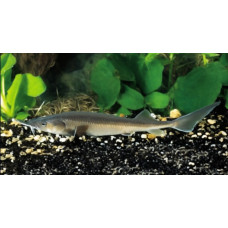Latin name
Huso baerii
Other name
Acipenser baeri, Acipenser baeri baicalensis, Acipenser baeri stenorrhynchus, Acipenser baerii baerii, Acipenser baerii baicalensis, Acipenser baerii baikalensis, Acipenser baerii stenorrhynchus, Acipenser baieri, Acipenser stenorrhynchus, Acipenser stenorrhynchus baicalensis.
Identification
The Siberian sturgeon has a spindle-shaped body with several longitudinal rows of bumps. Its short, triangular snout is located at the front of its head. Four rounded antennae without fringes are located on the underside of its head in front of its mouth. There are 12–19 scutes in the dorsal row, 37–56 in each lateral row, and 9–15 in each ventral row.
Features of fish fins
The upper lobe of the caudal fin of these fish is pointed and noticeably longer than the lower lobe. The dorsal, pelvic, and anal fins are located closer to the caudal part of the body. The anterior part of the dorsal fin sits behind the pelvic fins.
Fish colouring
The back of the Siberian sturgeon ranges in color from light gray to dark brown. Its belly color varies from white to bright yellow.
Distribution
It is widespread in Asia: Siberia, the Ob, the Irtysh, the Yenisei, the Lena, the Kolyma, the Khatanga, the Pyasina, the Anabar, the Olenyok, the Yana, and Lake Baikal. Non-migratory populations exist in all river systems.
Habitat
This is a freshwater and brackish, bottom-dwelling species that prefers temperate climates. pH range: 7.0 to 7.5. Depth range: 0 to 200 meters, typically 1 to 8 meters. It occurs in the deep and shallow parts of rivers with moderate to fast currents.
Size
These fish can grow up to 200 cm in length and weigh up to 210 kg. The maximum lifespan of the Siberian sturgeon is 60 years.
Behavior
Potamodromous specie. Adults primarily inhabit freshwater bodies, though some species are often found in estuaries. They spawn in the main river channel on gravel or gravel-sand bottoms in strong currents.
Food and feeding habits
This species of fish feeds on crustaceans (such as amphipods), insect larvae (such as caddisflies and chironomids), mollusks, and fish.
Reproduction
Under natural conditions, males reach sexual maturity at 9-1.5 years of age, and females reach sexual maturity at 16-20 years of age. In recirculating water systems, sexual maturity may first occur at 5 years of age. Spawning typically occurs every two years in the summer. After fertilization, the egg membranes become sticky, allowing the eggs to adhere to the substrate. Incubation lasts about 16 days at 10-15°. Larval development lasts approximately 20 days at 18°. The egg size is 3.0–3.6 mm, and the larva length at hatching is 10–12 mm.
Fishing
Commercial fish. The wild population of Siberian sturgeon is declining, so the fish are increasingly farmed for their meat and caviar.
Relationship with a person
Harmless. France is the main producer of Siberian sturgeon caviar, while Russia and China are the largest producers of sturgeon meat.
| Classification | |
| Phylum | Chordata |
| Class | Actinopterygii |
| Squad | Acipenseriformes |
| Family | Acipenseridae |
| Genus | Huso |
| Species | H. baerii |
| Features | |
| Conservation status | Critically Endangered |
| Habitat | Bottom |
| Life span, years | 60 |
| Maximum body weight, kg | 210 |
| Maximum length, cm | 200 |
| Sailing speed, m/s | No information |
| Threat to people | Edible |
| Way of eating | Predator |
Siberian sturgeon
Tags: siberian sturgeon

